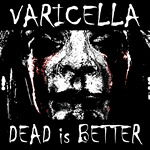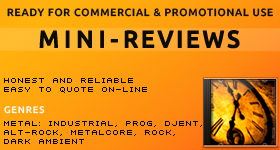| About Fabryka IR&M Encyclopedia |

|
| Latest reviews |
|
| Jump to |
| Home > All articles > 01. INDUSTRIAL ROCK STYLE FAQ > [Fabryka] Where does industrial music come from? |
| [Fabryka] Where does industrial music come from? |
 Fabryka Music Magazine covered: Fabryka Music Magazine covered:- industrial rock bands (see the list) - industrial metal bands (see the list) INDUSTRIAL ROCK [This article hasn't been updated since 2003] The differences between industrial and industrial rock Industrial rock should be kept separate from industrial, the core genre. The former appeared much later, and was only slightly inspired by industrial. It can be said that IR was created by adding industrial to raw, aggressive guitar music. IR is an easier listening and it's got more guitars, being less avantgarde and electronic at the same time. It usually has some vocals, while original industrial was based on sounds and infrequent comments. We shall focus on this a bit later. THE PRIME TIME ...in the case of IR is long past. Between 1989 and 1994 many good bands surfaced, with those already in the scene releasing great albums. In my opinion, the best era for IR began after 1988 (thanks to Ministry and their followers). Fear Factory, Godflesh and Skrew (among others) brought a lot of metal into the genre. [photo: Skrew] FEATURES Rock is rock - it's all about energy. On the other hand, the idea of the music is showing how this energy can be tapped by music software, samplers, sequencers, etc. Still, the most important element is the guitar riff, the more predatory it is, the better. As an example, the song can begin with a sampled dialogue from a movie, joined by drums. This is accompanied by a looped melodic riff, usually guitar or synthetic. The song evolves upon such structures and additional samples. Its tempo can also be increased, or the so called "wall-of-sound" (a cacophony of samples and riffs, noisy but not chaotic) effect can be used. [photo: Pitchshifter] PRODUCERS You should remember the following names: Bill Kennedy, Sean Beavan, Neil Kernon, Rick Rubin, Dave Ogilvie, Trent Reznor, Keith LaBlanck, Mark 'Flood' Ellis, John Fryer, Genesis P-Orridge, Al Jourgensen, Charlie Clouser, Jimmy "Foetus" Thirlwell, Alan Moulder, Martin Atkins. [photo: Trent Reznor] WHERE TO LOOK FOR? Industrial rock can be found in labels like: Wax Trax! (bought by and incorporated into TVT Records), TVT Records, Rough Trade, Earache, RoadRunner, Sire, 21st Circuity, Re-Constriction, Slip Disc, Bile Style, Fifth Colvmn Records, Energy Records, Van Richter, Nothing Records, DHR, Devotion, Columbia, Play It Again Sam, Mute, Music For Nations, Metropolis Records, Cleopatra Records, Sanctuary Records. Industrial and noise are also present in catalogues of Cold Meat Industry, Cop International, Ant-Zen, Metropolis Rec., Nettwerk, Nuclear Blast, Offbeat, SPV, Zothommog, Decibel. Poland: Metal Mind Rec. (an "indu" tag appearing before the material's ID), true industrial: War Office Propaganda. Industrial music was (and still is, usually) created with technology and electronics, but it's not limited to these media. You can create industrial using such live and simple instruments like a washboard or a snare. The music consists of two elements - a lot of electronica and raw sounds, similar to those found in punk rock or heavy metal. According to this, we can come up with the following definition of industrial music: DEFINITION Industrial as a music genre is characterized by a hard, solid sound of percussion instruments, electronic melodies, distorted vocals and an overall cut-and-paste design. Performers are usually white, full of anger, alienated, rebelling, touched by pain and overpowering control. Dance industrial peruses repeating patterns and group chants based on a verse-verse-chorus-verse scheme. The foreground is occupied by the beat or the drums. Many industrial tracks begin with synthetically generated beats, continuing in a stable, repeating pattern. Although the majority of industrial tracks are not really dance-friendly, they might seem good dance tracks due to the overwhelming beats. Industrial borrows heavily on electronica, composing the body of a song. These could be looped melodies or samples taken from various sources (usually movies). Other frequently used elements are: metallic, dehumanized sounds produced by operating machines (e.g. sounds made by tools, metal objects, drills, jackhammers, moving cyborgs or robots, factory machinery and very often the sound of compressed air from some hydraulic systems or the sound of machine gun shells hitting the floor). The last element is the technique of song creation. It it always done using the cut-and-paste method, originating from the software commands (usually ctrl+x, ctrl+v). Different tracks stay bound together on specific strata, signaling their multilevel structuring. The blueprint for an industrial track looks more or less like that: repeating hums of different frequencies, shards of dialogues, voices sifted through guitar-effects, shocking and disgusting lyrics combined with graphical visuals based on war atrocities, medical photographs, pornography - generally, everything that can cause some sick interest. Simon Raynolds remarked correctly that "groups generating noise are closely connected with psychopathies." Therefore, industrial music is defined as "dehumanized." It's worth noticing that technology became so user friendly that everyone who knows how to run a sequencer, some music software and how to connect a microphone to a fuzztone, could easily and quickly produce a neat industrial track. The genre enjoyed significant ferment between 1991 and 1996.  INDUSTRIAL IN THE DEATH FACTORY INDUSTRIAL IN THE DEATH FACTORYIndustrial (the music genre) came into being (and was later propagated) thanks to Genesis P-Orridge in 1975. It happened in a cellar (where else?), in Hacknay - a district of London. The cellar was called the Death Factory, because a mass grave of people who died in the 17th century because of the plague could be found in a nearby park. In such a neighbourhood, Genesis tried to give music a new face. His broodings led him to a singular conclusion - there is no slavery in the cotton field anymore. Slavery moved to factories, with people repeating activities till they dropped, surrounded and dominated by noisy machines. We live in an industrialized society. Therefore, new music came to life as industrial, and the first industrial record released through Industrial Records is "The Second Annual Report" by Throbbing Gristle, fronted by P-Orridge. Industrial Records became later the home for groups like Cabaret Voltaire, S.P.K or Clock DVA.  THE FUTURIST MANIFESTO ON THE ART OF NOISE (1913) THE FUTURIST MANIFESTO ON THE ART OF NOISE (1913)"Noise was born in the 19th century, coming to life through machines. Today, noise is triumphant over Man's sensitivity. (...) The sound in music is too limited in its multiplicity (...) We have to break the limited circle of sounds and rule the infinite variety of noises." - These are Luigi Russolo's words. His concept was based on the Futurist Music Manifesto of 1911 by Balill Pratell, who wrote: "music must represent the spirit of the folk, the spirit of the huge industrial combines, trains, ships, automobiles and aeroplanes." Russolo invented such instruments as the Whistler, the Burner and the Croaker, each of them generating a certain level of noise. [photo: Luigi Russolo]  INDUSTRIAL COEXISTS WITH THEATRE... INDUSTRIAL COEXISTS WITH THEATRE...If we take into account that industrial music was initiated by Genesisa P-Orridge, who was also a member of an art group called COUM Transmissions, the connections between industrial and are seem clear. In 1969 Genesis met then 16-year-old dark-haired Cosey Fanni Tutti, drawn into Throbbing Gristle as a guitarist. She also became his lover and collaborator in many artistic acts committed by COUM Transmissions. The troupe's shows were very frivolous to say the least - the performances consisted of self-mutilation, urine drinking, masturbation, sexual intercourses. The aim was to expose the taboos that surround sex, rituals and shamanism since time immemorial. P-Orridge pierced his scrotum with a needle, injecting the blood back into his forearm veins, or he masturbated with chicken heads. Industrial music is used to this day as the background to a vast array of performances, happenings, theatrical shows or short documentaries. [photo: Throbbing Gristle].  ...ART AND LITERATURE... ...ART AND LITERATURE...Dadaists. "Dada" (French, a term describing a toy or the first words uttered by a child) was an avantgarde movement in art and literature, created in Switzerland in 1916 (in Zurich, Tristian Tzara and the animators of the Cabaret Voltaire club mock art, politics, customs and common knowledge). It was meant to oppose logic, ethical and moral standards and, praising imagination, fantasy, unconventionality, spontaneity, creativity and improvisation. The dadaist poets were not worried by the nonsense they created. Dadaist art was about mockery. The dada artists mocked themselves, created absurd pieces, with their overarching idea of a rebellion against tradition and the aesthetic canons of art and literature. Futurists believed in the future, dadaists believed in nothing, not even in their own art. One of the manistestos discussed art creation using the collage technique. "Put words into a hat, stir it, pull some random ones out, put them together however you want, and you have a dada poem." Such pieces were clusters of inarticulate sounds or loose automatically connected wordstreams (e.g. Bruno Jasienski and his "Shoe in the Buttonhole"). The same kind of art came from William S. Burroughs (below). In fine arts, buffoonish and ironic pictures were created, using collage and assemblage of newspaper clippings, rags, plastic, glass, straw and photography (trick photos). Children naivety and deformed beauty were all the rage. The literary theme became irrelevant - the contrastive play of colours and shapes was what mattered. A new branch of art and architecture was born - town-planning. Painters were mostly ironic (e.g. Duchamp gave Gioconda a moustache). For his paintings, Picabia used materials like feathers, wires or matches; he also used objects (using objects was broadly implemented in surrealism, which followed dadaism). [photo: dadaism]  ...AND MUSIC ...AND MUSICIn music, the focus was on the "mathematical" design of a song, full of cold calculation, pure intellect and extreme formal concepts. The traditional minor-major scale was forfeited, together with the rule that a song must be composed in a certain key. The atonal scale with 12 half-tones was introduced by Arnold Schonberg, Alan Berg and Anton Webern. Harmonies and melodies were crushed, with contrast and dissonance highlighting the uneasy, nervous and suprising expression. |
Published by Draconina
Updated on 09/01/2007 15:38
20233 Reads [The number of reads drops with every database update]

|
| Legal notices, copyright |
| Search in the magazine |
| Fabryka is hosted by |
| Versions |
| Varicella - Dead is Better |
 |
| Navigation |
 HOME HOMEREVIEWS INTERVIEWS
 All reviews All reviews Short music reviews part 1 Short music reviews part 1 Short music reviews part 2 Short music reviews part 2 All interviews All interviews Short movie reviews Short movie reviews Testimonials TestimonialsARCHIVED CONTENT
 About Fabryka Magazine About Fabryka Magazine What's industrial rock? What's industrial rock? Quick encyclopedia Quick encyclopedia Industrial manifestos pdf Industrial manifestos pdf Podcast archives Podcast archives News archives by year News archives by year Article archives by year Article archives by year All article archives All article archives Legal music Legal music Fabryka promo events Fabryka promo eventsINTERNAL
 Staff StaffART, WOODWORKING & CD COVERS
Draconina's art on DeviantartOTHER WEBSITES
PhilodendronsFire Dragon's Gemstones Drakonia Tarot |
| New and updated articles |
| Opportunities |

 Detailed single song review + publishing Detailed single song review + publishing
 Detailed album review + publishing Detailed album review + publishing

 Mini-review Mini-review

 Promotional interview + publishing Promotional interview + publishing |
| Subscribe |
|
|
| Content (open) |  |
| Keywords (open) |  |




 Reviews and interviews:
Reviews and interviews: